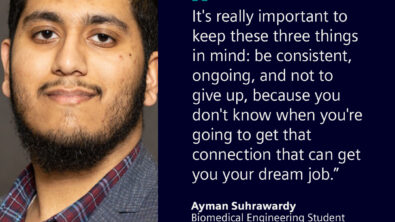Great ideas and immersive engineering: Get inspired for the Immersive Design Challenge

Siemens and Sony are challenging students worldwide to imagine sustainable design with immersive engineering. The Immersive Design Challenge is an exceptional opportunity to learn with experts during webinars and inspirational talks, develop key employability skills and build a global network among industry and peers. At its core, the challenge invites teams of students to imagine how they would use immersive design to make a product of their choice more sustainable.
Keep reading as we explore the benefits of this technology and share tips for generating exceptional ideas, inspired by insights from a recent webinar with Ben Widdowson, head of marketing for immersive engineering at Siemens.
While the application deadline for this challenge has now passed, sign up for our email updates and be the first to hear about upcoming opportunities for engineering students and learners.
The power of immersive engineering
Immersive engineering combines the real and digital worlds, enabling designers to experience 3D CAD in an industrial metaverse. According to Ben, who has been deeply involved in this project, the technology resolves a long-standing barrier in the adoption of XR in design. “The biggest problem we have been looking to solve is to have a solution that is first and foremost designed for designers and engineers.” By integrating Sony’s XR head-mounted display with Siemens’ NX Immersive Designer, the process eliminates the need for tedious data exports, allowing live updates and real-time immersive design.
For Ben, this project brings to life advanced design capabilities that may feel like science fiction into real-world applications. “Why aren’t we able to, as designers and engineers, create like this?” he asked, pointing out the limitations of existing tools and the revolutionary potential of this technology.
What makes the Siemens & Sony solution unique?
Unlike other XR tools, the combination of Siemens’ software and Sony’s unique XR head-mounted display provides the most natural and intuitive way to create and experience the digital twin of your product or process. “You can launch into immersive immediately. There’s live updates, so anytime you make a design change, it’s displayed in real time,” Ben explains.
This integration enables:
- Enhanced collaboration: Teams can communicate complex 3D designs more effectively with non-technical stakeholders.
- Better design context: Designers can see their creations in 3D, improving their understanding of scale and interaction within a human context.
- Sustainability advantages: Immersive design reduces the need for physical prototypes and travel, making the process more environmentally friendly.
Inspiration from early access users
Some of Siemens’ early access customers have already shown the potential of immersive design. Natilus, an aerospace company, are using the technology to design a blended wing-body aircraft that improves fuel efficiency and cargo capacity. They also engage stakeholders by showcasing designs in an immersive environment. Ben notes, “They can show how freight containers will fit into the aircraft, enabling smoother commercial conversations.”
How to generate great ideas for the challenge
Generating a standout idea starts with identifying real-world problems and applying a design thinking approach. Here are some key steps to help come up with impactful ideas:
- Look around in your field, or in your own daily life – the problem you might address could be right under your nose. From suitcases to bicycles, the simplest products can spark innovation.
- Empathize and understand the needs of the end-user. This could involve interviewing people, observing how they interact with products or identifying pain points.
- Define the problem and fame the challenge clearly. For example, “How might we design a suitcase that reduces strain for petite travelers?” This clarity guides brainstorming.
- Brainstorm creatively – use techniques like sketching or prototyping with basic materials to visualize your ideas. Prototyping doesn’t need to be high-tech initially; focus on communicating the concept.
- Consider how your idea contributes to sustainability. For instance, can your design reduce energy consumption, material waste or carbon emissions?
- Form a multidisciplinary team with peers from various disciplines to bring fresh perspectives. Diversity of thought enhances creativity!
Why join the challenge?
All participants in the Immersive Design Challenge have the chance to:
- Learn with experts during webinars and inspirational talks.
- Develop key employability skills.
- Build a global network among industry professionals and peers.
- Get access to free software and professional certifications.
- Obtain industry-recognized microcredentials on sustainability, like that offered by the “Applied Sustainability for Technical Managers” specialization for graduate students at Coursera courtesy of Siemens and CU Boulder.
For the teams that go further…you can earn great Siemens merch, work directly with Siemens mentors to take your designs further and be among the first in the world to work with the Sony XR head-mounted display/NX Immersive Designer either on campus or at Siemens. The winning team’s university will receive a Sony XR head-mounted display as well as one-year NX Immersive Designer license.
The challenge is open to bachelor’s, master’s or PhD students from any discipline, enrolled thru March 2025. Teams should comprise three to five students with at least one team member learning or ready to learn CAD/NX to create a successful entry. The first round requires responses to just five short questions.
While the application deadline for this challenge has passed, sign up for our email updates and be the first to hear about upcoming opportunities for engineering students and learners.


